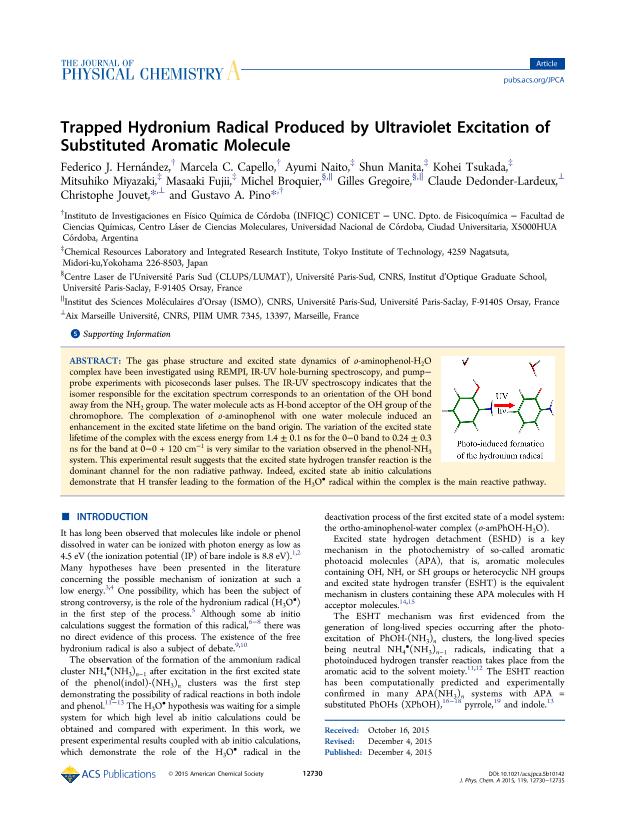Artículo
Trapped hydronium radical produced by ultraviolet excitation of substituted aromatic molecule
Hernández, Federico Javier ; Capello, Marcela Carolina
; Capello, Marcela Carolina ; Naito, Ayumi; Manita, Shun; Tsukada, Kohei; Miyazaki, Mitsuhiko; Fujii, Masaaki; Broquier, Michel; Gregoire, Gabriel Eduardo; Dedonder Lardeux, Claude; Jouvet, Christophe; Pino, Gustavo Ariel
; Naito, Ayumi; Manita, Shun; Tsukada, Kohei; Miyazaki, Mitsuhiko; Fujii, Masaaki; Broquier, Michel; Gregoire, Gabriel Eduardo; Dedonder Lardeux, Claude; Jouvet, Christophe; Pino, Gustavo Ariel
 ; Capello, Marcela Carolina
; Capello, Marcela Carolina ; Naito, Ayumi; Manita, Shun; Tsukada, Kohei; Miyazaki, Mitsuhiko; Fujii, Masaaki; Broquier, Michel; Gregoire, Gabriel Eduardo; Dedonder Lardeux, Claude; Jouvet, Christophe; Pino, Gustavo Ariel
; Naito, Ayumi; Manita, Shun; Tsukada, Kohei; Miyazaki, Mitsuhiko; Fujii, Masaaki; Broquier, Michel; Gregoire, Gabriel Eduardo; Dedonder Lardeux, Claude; Jouvet, Christophe; Pino, Gustavo Ariel
Fecha de publicación:
04/12/2015
Editorial:
American Chemical Society
Revista:
Journal of Physical Chemistry A
ISSN:
1089-5639
e-ISSN:
1520-5215
Idioma:
Inglés
Tipo de recurso:
Artículo publicado
Clasificación temática:
Resumen
The gas phase structure and excited state dynamics of o-aminophenol-H2O complex have been investigated using REMPI, IR-UV hole-burning spectroscopy, and pump–probe experiments with picoseconds laser pulses. The IR-UV spectroscopy indicates that the isomer responsible for the excitation spectrum corresponds to an orientation of the OH bond away from the NH2 group. The water molecule acts as H-bond acceptor of the OH group of the chromophore. The complexation of o-aminophenol with one water molecule induced an enhancement in the excited state lifetime on the band origin. The variation of the excited state lifetime of the complex with the excess energy from 1.4 ± 0.1 ns for the 0–0 band to 0.24 ± 0.3 ns for the band at 0–0 + 120 cm–1 is very similar to the variation observed in the phenol-NH3 system. This experimental result suggests that the excited state hydrogen transfer reaction is the dominant channel for the non radiative pathway. Indeed, excited state ab initio calculations demonstrate that H transfer leading to the formation of the H3O• radical within the complex is the main reactive pathway.
Archivos asociados
Licencia
Identificadores
Colecciones
Articulos(INFIQC)
Articulos de INST.DE INVESTIGACIONES EN FISICO- QUIMICA DE CORDOBA
Articulos de INST.DE INVESTIGACIONES EN FISICO- QUIMICA DE CORDOBA
Citación
Hernández, Federico Javier; Capello, Marcela Carolina; Naito, Ayumi; Manita, Shun; Tsukada, Kohei; et al.; Trapped hydronium radical produced by ultraviolet excitation of substituted aromatic molecule; American Chemical Society; Journal of Physical Chemistry A; 119; 51; 4-12-2015; 12730-12735
Compartir



